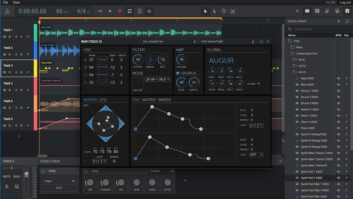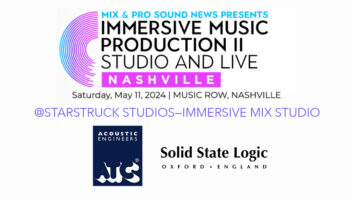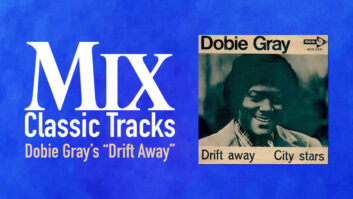
New York, NY (October 22, 2024)—New York Comic Con hit the Big Apple this past weekend, taking over the Jacob Javits Convention Center as it hosted more than 200,000 attendees from October 17 through 20. I still remember attending the first NYCC 19 years ago—held in a single basement room of the Javits, the event was so unexpectedly popular that it had to be shut down for an hour by fire marshals due to overcrowding. Of course, for a first-time show, that’s a great problem to have and in the years since, NYCC has grown into a sleek, smoothly run pop-cultural juggernaut that has an economic impact of $80 million annually for New York City, according to New York City Tourism + Conventions.
Coincidentally, the Audio Engineering Society Convention was held at the Javits less than a week earlier, and while it’s safe to say NYCC featured a lot more capes and costumes than AES, pro-audio had a place at both events. For the AES Show, that meant panels featuring producers and engineers, and a show floor full of recording gear; for NYCC, it meant exhibitors like soundtrack specialist Milan Records could be found on the show floor, while audiobook/podcast service Audible held multiple panels throughout the four days, taking fans behind the scenes on some of their favorite audio series.
In particular, Thursday saw Audible host The Sounds of Storytelling! How the Genre’s Greatest Writers and Narrators Take Listeners on the Ride of Their Lives, bringing together a bevy of science fiction authors and performers—including a few who wore both hats—to discuss the creative process that goes into an audio series. Panelists included Emily Andras (Wynonna Earp), Mary Robinette Kowal (The Lady Astronaut series), Ray Porter (The Bobiverse series, Project Hail Mary), R.A. Salvatore (The Legends of Drizzt), John Scalzi (Starter Villain, Constituent Service), and Dennis E. Taylor (The Bobiverse series).
Each panelist brought their own insights to the table, from interpreting words to writing them, and while the conversation didn’t have to do with recording gear, it did focus on what recording equipment is ultimately used for—to create an engaging experience for the listener.
Ray Porter, who has performed more than 500 audiobooks as a narrator, explained why there was far more to finding and conveying a character than just settling on a distinct accent to help the listener know who’s speaking. “It becomes about personality, it becomes about intent—it isn’t necessarily about a different voice, but [rather] a different attitude, a different outlook, a different way of viewing whatever the circumstance is,” he said. “That’s true of pretty much any character. You can take any accent you want—and authors love throwing in the accents—but if you don’t have the nuts-and-bolts intent of whatever the scene is, and if you’re not able to actually look at it like ‘what does this person want,’ [then] it doesn’t matter what kind of a voice, what kind of dialect, or anything that you put on it. I know a lot of people who are versatile vocally [but] you also have to have that versatility with your thinking, with intention and getting next to what the script is.”
Report: Spoken Word Audio On The Rise
Mary Robinette Kowal brought a unique perspective to the proceedings, as she’s an award-winning writer, but also a veteran audiobook narrator as well. With that in mind, she spoke about the conflicts that arise from wearing both hats—and a slick trick her recording engineer uses to add verisimilitude to some of her line readings
“The narrator Mary Robinette really does hate writer Mary Robinette,” she cracked. Discussing challenges she faced narrating the audiobooks of her Lady Astronaut series, she shared, “It’s an international organization, the International Aerospace Coalition, so I wanted to represent all of those people, and I put in a bunch of languages I don’t speak—big, long sentences! Sure, I totally know how to speak Croatian—that is 100% a thing that I can do! So I write it the way the story needs to be written, and then I trust that my narrator will figure it out…. I also have a really good engineer who is willing to let me take as many takes as I need to in order to get it to sound passable—and then he speeds it up a little bit so I sound fluent.”
Adapting a project from a visual medium like television to an audio-only format can have its challenges but also its benefits, as Emily Andras, the creator and showrunner of the TV series Wynonna Earp, made clear. Discussing her new Audible Original series, Wynonna Earp: Tales from Purgatory (available in Dolby Atmos, no less), Andras found that writing for the unlimited budget afforded by one’s imagination was a boon: “We were able to tell stories in a new environment—on a plane, on an old-timey Western train—and do things that we always wanted to do…with this new soundscape, so it was incredibly freeing. Wynonna Earp is the descendant of Wyatt Earp, so there’s a very big contingent of Old West lore that comes with it; being able to go back in time and look back at her famous ancestors’ history was great. We could afford a train whistle! I’m spoiled for whistles; thank you, Audible.”
While many multi-actor audio series record performers separately, that wasn’t the case with the new Wynonna Earp production, she said: “Audible put the whole cast in the same room when they were recording, and that was such a boon to the emotion and the spirit of them, that they could still look into each other’s eyes and perform almost like a play. I think you can really hear the results, and it was just so rich. I absolutely loved it.”







